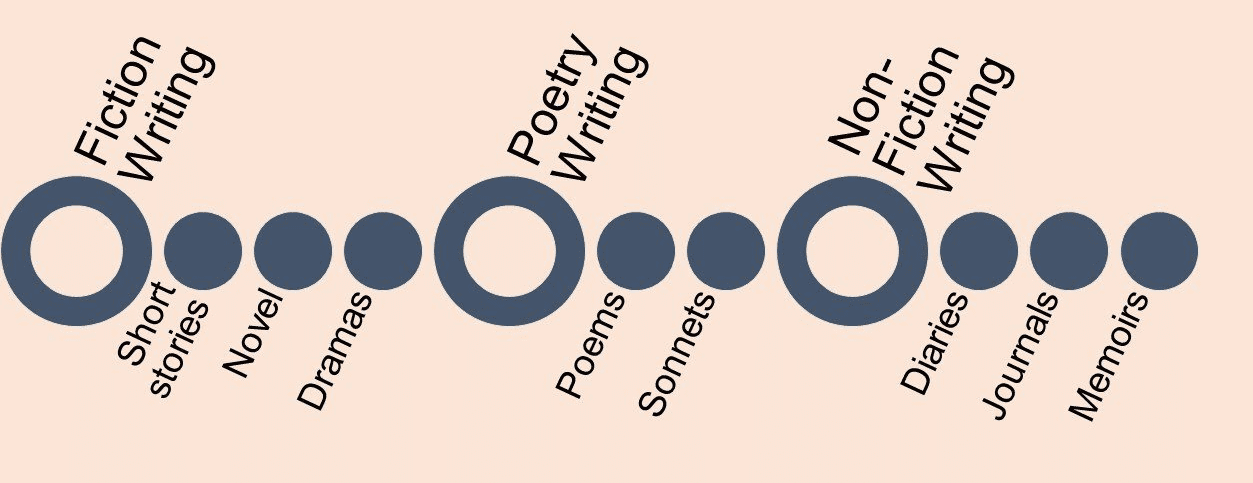Creative writing in all its manifestations – poetic impromptu, humorous story, screenplay, novel, or essay – serves several purposes at once. Namely:
- Gives a personal point of view. Such works are more “human” because they provide readers with an explanation of the author’s worldview.
- Engages readers with the structure of the story. For example, changes in chronology, references to the past or future, historical footnotes and other deviations from the dry presentation of facts make readers empathize, rejoice, anticipate – experience the full range of emotions about what is happening in the presentation. This also includes delaying the solution – it encourages readers to read to the end.
- Conveys the main idea. A collection of short stories, a script for a TV series, or a multi-volume novel can revolve around a single topic through well-thought-out information organization.
Depending on the placement or application, you can choose one of the top types of creative writing – a short story, a story, a sonnet, a memoir, a fairy tale, a poem, etc. We will talk about them in more detail in the article below.
What is Creative Writing

Creative writing is the text written using creative techniques to convey information. Creative writing goes beyond the standard professional, journalistic, technical, or academic forms of writing. Any presentation of information outside of these categories is already considered creative writing.
Creative writing refers to texts in various genres and stylistic categories. This includes both fiction and science fiction—drama, poetry, nonfiction, prose, and storytelling.
Elements of creative writing
The following techniques are used to create an effective and high-quality text, regardless of the chosen form of creative writing.
Plot
A unique idea, embodied in a compelling story, is an important element in creating an entertaining story. Unfortunately, the dry presentation of facts and the lack of a coherent, well-thought-out plot make the story slurred and boring. As a result, the story does not achieve its goal, and the readers’ attention is lost.
Throughout
Every story has action characters. And throughout the history of the story, it is necessary to reveal their characters. Show how they change their views and actions under the influence of the events. Through characters, you convey a story. They are remembered by readers, causing empathy and affection.
Underlying Theme
The central concept that you hold and uncover as the story progresses is the common thread throughout the text. This is its meaning, core, leitmotif, “red thread.” So, for example, the main theme may be an experience, a lesson – it is called a “moralistic message.”
Visual Descriptions
The description of the geographical location of the action allows the reader to plunge fully into what is happening and imagine himself in the place of the characters. This is an integral part of the story – the visualization of the environment of the storyline creates a background and overall atmosphere and tells more about the characters.
Imaginative Language
Techniques of figurative language inherent in creative writing – metaphors, hyperbole, comparisons, figures of speech. They emphasize the narration style, make the text brighter, more readable and help convey some thoughts more clearly.
5 Type of Creative Writing

Literature, in all its diversity, allows authors to choose the form of presentation of thoughts that fully reveals their personality and the creative writing theme.
Poetry
Although poetry is not among the top popular forms of creative writing, it should be in every writer’s arsenal. Writing poetry is a great way to train your writing skills and force your brain to think differently. There are dozens of forms of writing poetry – each word is carefully thought out, leaving imprints on the readers’ memories and evoking powerful emotions.
Plays
Like scenarios, short stories describing the actions and dialogues of the characters may consist of just one act or two or more. The form of construction makes them an ideal tool for revealing the plot to the public.
Movie and television scripts
Scripts are needed for everything broadcast on television – for commercials, programs, and films. Their length varies depending on the type.
Speeches
The format is similar to an essay but with a clear motivating or inspiring message. The peculiarity of this type of creative writing is that a speaker can say up to 100 words in a minute. Therefore, the speech must be written with a clear arrangement of accents so that, in the end, the incendiary speech does not turn into an incoherent monologue. Creative writing services are designed to help people achieve great results when they start from scratch.
Memoirs
Memoirs refer to creative nonfiction literature. The purpose of a memoir is to explore and describe a person’s life and experience. Memoirs can describe only a certain segment or a whole life. Firstly, there are some differences from an autobiography: any other person can act as the author. Secondly, they are more emotional since attention is focused on individual moments and the emotional component.
9 Creative Writing Exercises to Improve Your Writing
There is no limit to perfection – and even more so to the perfection of creative writing. Therefore, we share the best exercises for developing this skill.
Write a scene or short story using no adverbs or adjectives.
Restrictions give impetus to the new, allow you to look for a way out of the situation, learn the richness of the language, and teach you to write differently. For example, letting go of adverbs and adjectives will open up a world of stronger verbs and nouns. At the same time, this exercise will make your subsequent texts stronger, saving them from the excess of adverbs and adjectives.
Write From Different Perspectives
Write the same work from all possible positions. Alternatively, from the standpoint of diverse characters, a real historical figure, or a person you don’t like. Moreover, the latter can be a challenge for you, which is more exciting. This will expand the understanding of the described plot and teach you to think more diversified manner.
Write Metaphor Lists
Metaphors are one of the most notable examples of figurative language. As a practice, make two columns: in one, write literal objects and phenomena (table, sky, pen, etc.), and in the next one – abstract (sadness, rage, charm, ignorance, etc.). Then choose one random concept from each column and try to explain one to the other – create a metaphor. For example, by choosing “pillow” and “love,” you can create such a comparison: “Love is like a pillow – it can give peace, but it can also suffocate.”
Speed-write a story using a writing prompt
You will find such hints on the Internet or other people’s works. These are phrases, words, sentences, preambles of stories, or even a picture – everything that will give impetus to the text. This approach stimulates the imagination and motivates the brain to generate ideas based on available material.
“Write your dialogue like it’s a script.”
The idea belongs to professional critic Gloria Russell. The bottom line is that writers often focus on descriptions of location emotions but miss the importance of the dialogue itself. There is an opportunity to imagine the opposite in this exercise – to make the conversation key. This will help in the future to correctly place emphasis.
Write about your expertise.
Describe one of your skills, do it as if you are explaining its essence to someone else. The basis can be an elementary skill or experience – for example, washing dishes. In your story, pay attention to the details, the subtleties of the process and the features of the execution of the work. And add emotion.
Write a story told to you.
Turn the story said to you into an entertaining piece of literature. It can be any plot – memories of the past performed by a grandmother, a recent situation that happened to your friend, or a story from the life of a famous person.
Write about something or someone who changed your life
Lead the story on your behalf and talk about your emotional impressions – in other words, share your story. Avoid a formal retelling, but write about what influenced you, what feelings it caused and how it changed your personality. As a result, you will get a deep, lively and sincere story.
Write flash fiction
A kind of short prose characterized by its brevity. A quick, short story, no more than 500 words, must contain an accurate plot, denouement, character development, emotion, and conflict. The most prominent, illustrative example of flash fiction is credited to Ernest Miller Hemingway. He wrote a 6-word mini-story: “For sale, baby shoes, never worn.”
Conclusion
Creative writing is the result of working on your craft. Don’t focus on one type of writing, but practice different styles. Train your mind to use new techniques for yourself. You will see how the ability to write high-quality and exciting texts improves with each subsequent word.
